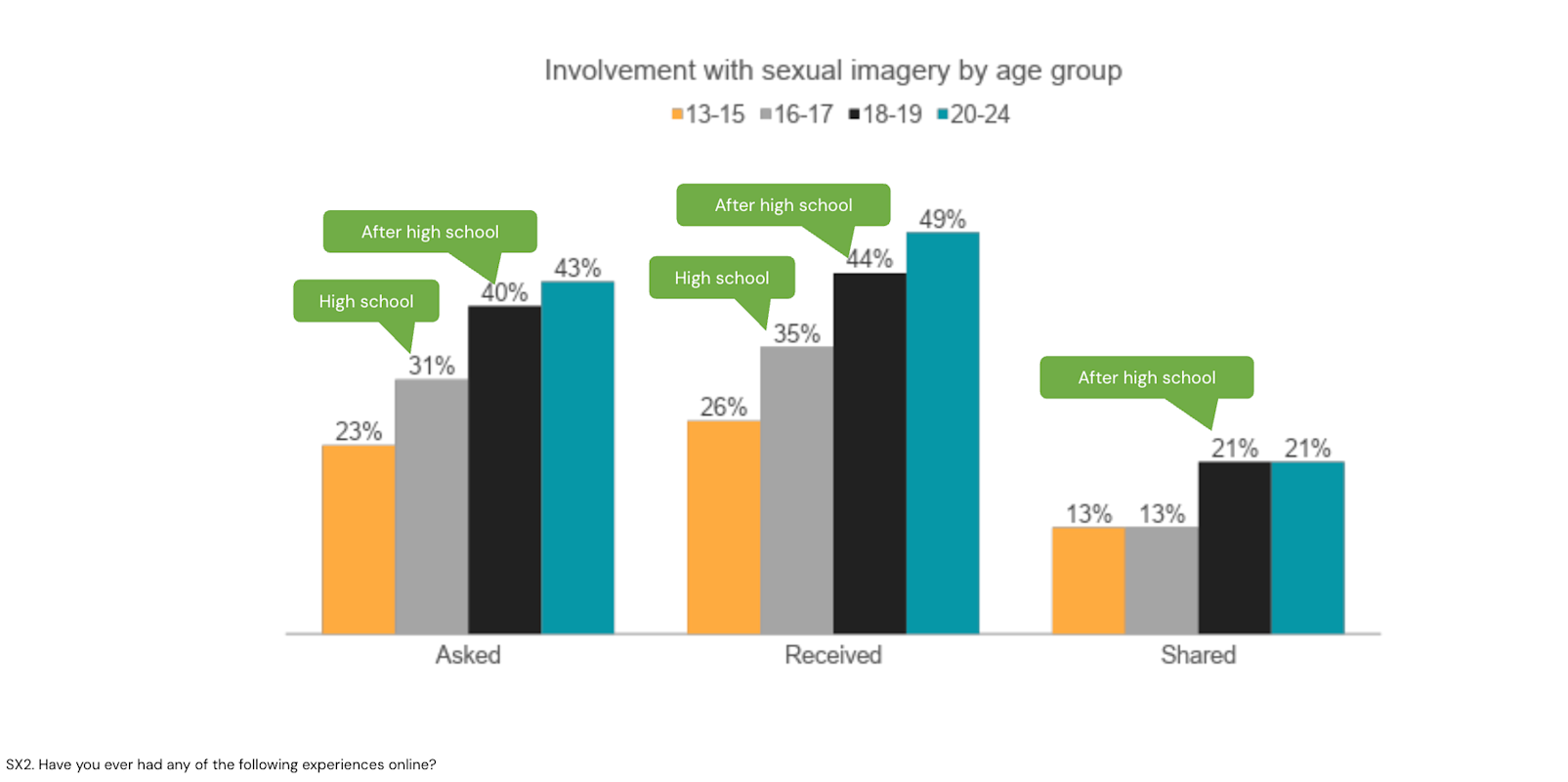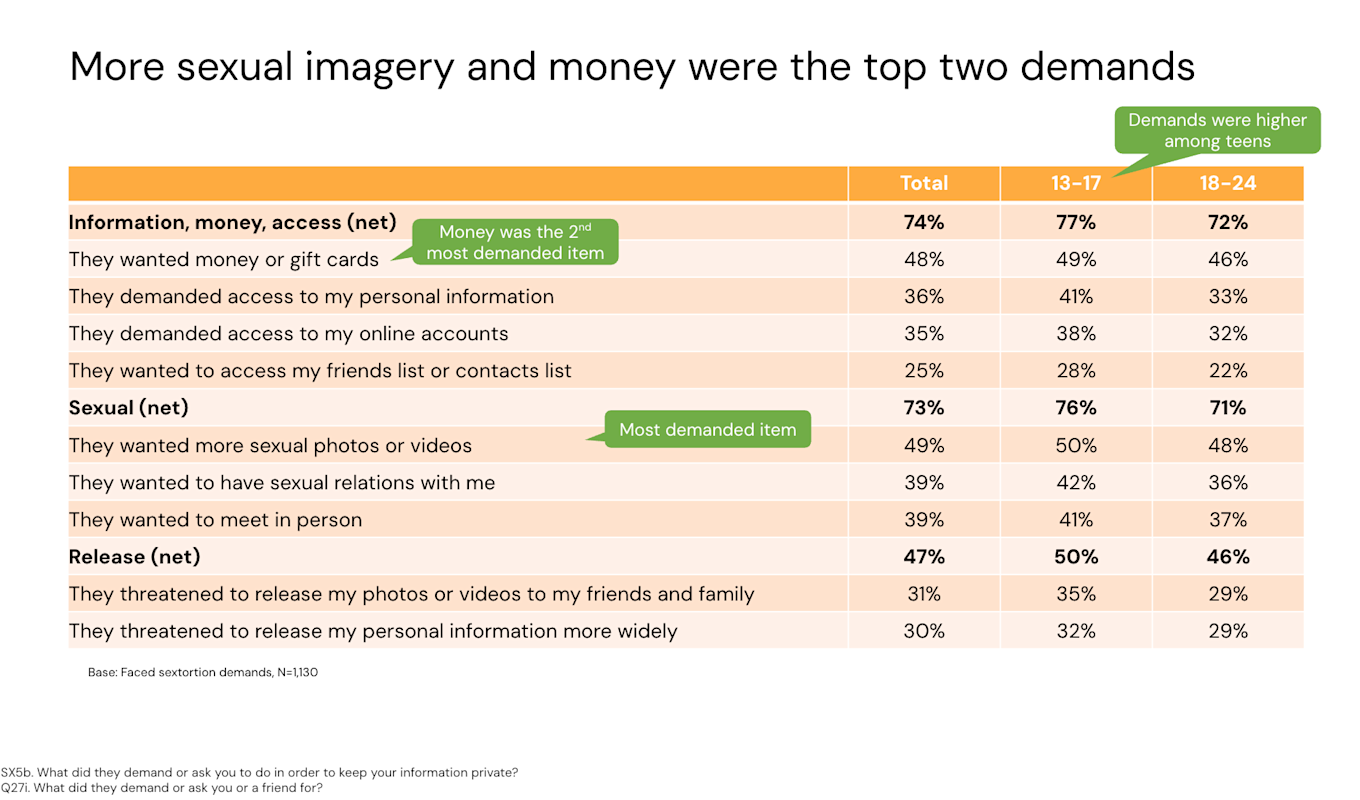Nouvelle étude de Snap : la génération Z reste une cible de la sextorsion en ligne, mais nous observons des signes de progrès en la matière
29 octobre 2024
Our Continued Efforts to Thwart Online Child Sexual Exploitation
Au cours de ces trois dernières années, l'environnement des risques en ligne a été témoin d'une augmentation vertigineuse de la « sextortion » – des escroqueries qui abusent principalement des adolescent(e)s et des jeunes adultes en les incitant à partager des images intimes qui se traduisent rapidement en chantage. Bien que de nouvelles recherches réalisées à l'échelle du secteur montrent que les risques persistent, il existe des signes encourageants indiquant que les efforts visant à déjouer les délinquants et à sensibiliser les cibles potentielles prennent racine. (Snap Inc. a commandé cette recherche, qui en est maintenant à sa deuxième année, sachant qu'elle couvre les expériences des adolescent(e)s et des jeunes adultes de la génération Z sur les plateformes en ligne en général, sans mettre l'accent spécifiquement sur Snapchat.)
Près d'un quart (23 %) 1 des 6 004 personnes âgées de 13 à 24 ans interrogées dans six pays 2 toutes plateformes et services confondus ont déclaré avoir été victimes de sextorsion. Par ailleurs, plus de la moitié (51 %) des personnes interrogées ont déclaré avoir été attirées dans certaines situations en ligne ou avoir adopté des comportements numériques risqués qui auraient pu aboutir à de la sextorsion. Cela comprend notamment le « pédopiégeage 3 », (37 %), le fait d'être victime d'une « cyberimposture » (30 %), d'être piraté (26 %), ou de partager des images intimes en ligne (17 %). Fait important, les campagnes de sensibilisation et d'éducation permanentes menées par plusieurs groupes semblent porter leurs fruits de telle sorte que moins de jeunes « ciblé(e)s » sont en fait victimes de ces arnaques.
On parle de « catfishing » en ligne lorsque des criminels se font passer pour quelqu’un d’autre afin d’inciter une cible à partager des informations à caractère personnel ou à produire des images à caractère sexuel. Le piratage implique généralement qu'un(e) délinquant(e) accède de manière non autorisée aux appareils ou aux comptes en ligne d'une cible pour lui voler des photos intimes ou des informations à caractère personnel. La plupart du temps, dans les deux scénarios, les vidéos, les photos ou d'autres informations privées acquises sont ensuite utilisées pour faire chanter la victime afin qu'elle réponde aux exigences de l'auteur supposément en échange de la nonpublication des images compromettantes à la famille et aux ami(e)s de la personne.
Le partage volontaire d'images numériques intimes entre les jeunes est largement perçu comme une exploration sexuelle au 21ème siècle et cette caractérisation est soutenue par des recherches. Mais cette pratique reste un vecteur de risque clé pour la sextorsion et d'autres préjudices potentiels découlant de fausses déclarations et d'impostures. Les dernières découvertes montrent que sur les 17 % de personnes interrogées qui ont admis avoir partagé ou distribué des images intimes, 63 % ont déclaré avoir été dupées par l'auteur de l'infraction et 58 % ont déclaré avoir perdu la maîtrise du contenu une fois envoyé. Les personnes de moins de 18 ans qui ont partagé des images intimes étaient particulièrement vulnérables : 76 % ont déclaré avoir été dupées par l'abuseur et 66 % ont déclaré avoir perdu le contrôle des images.
« Les adolescents veulent une réglementation et des systèmes de recours plus stricts pour renforcer leur sécurité en ligne, » a déclaré la Professeure Amanda Third, co-Directrice du Young and Resilient Research Centre de la Western Sydney University, qui a mené une étude en parallèle 4 en partenariat avec l'ONG Save the Children, avec le financement de la Tech Coalition. « Ces acteurs veulent que les enfants et les adultes soient mieux sensibilisés. Ils appellent les plateformes à exploiter la puissance de l'intelligence artificielle et d'autres capacités techniques émergentes pour garantir que les espaces numériques qu'ils fréquentent sont exempts de personnes malveillantes, de contenus inappropriés et comportent non seulement des contenus sûrs, mais également optimaux pour eux. »
« Des designs bien pensés et adaptés à l'âge qui peuvent aider les enfants à identifier les personnes malveillantes, fournir des suggestions en temps réel sur la façon de réagir aux interactions inappropriées et les mettre en relation avec des informations de haute qualité et des moyens d'obtenir de l'aide sont nécessaires de toute urgence pour aider à combattre la forte augmentation des extorsions sexuelles en ligne », a-t-elle ajouté. La professeure Third est également membre du Conseil consultatif de sécurité de Snap.
Autres résultats clés
Près de la moitié (47 %) des personnes interrogées appartenant à la génération Z ont déclaré avoir eu affaire à des images intimes à un moment donné : 35 % ont été invitées à partager des photos ou des vidéos sexuelles, et 39 % ont déclaré avoir reçu des images.
L'utilisation des images sexuelles a augmenté à l'ère de la génération Z.
Parmi les adolescent(e)s âgé(e)s de 13 à 15 ans, environ un quart avait été invité à partager (23 %) ou avait reçu (26 %) des images intimes. Seulement 13 % ont admis en avoir partagé.
Parmi les adolescent(e)s âgé(e)s de 16 et 17 ans, ces pourcentages ont bondi à 31 % (partage d'images intimes) et 35 % (réception d'images intimes), sachant que seulement 13 % ont admis avoir partagé des images à caractère sexuel.v
Les pourcentages ont encore augmenté chez les personnes âgées de 18 et 19 ans et de 20 à 24 ans, atteignant 43 % (partage) et 49 % (réception) dans cette tranche d'âge la plus âgée. (Voir le tableau pour obtenir des informations détaillées).

La recherche fait partie de l'étude permanente de Snap sur le bien-être numérique - un indicateur de la santé psychologique en ligne de la génération Z. Bien que Snap ait financé cette recherche, elle couvre toutes les plateformes, services et appareils, sans mettre l'accent spécifiquement sur Snapchat. Menée du 3 au 19 juin en Australie, en France, en Allemagne, en Inde, au Royaume-Uni et aux États-Unis, un total de 9 007 personnes ont participé à cette étude, dont 3 003 parents de jeunes de 13 à 19 ans, qui ont été interrogés sur l'exposition de leurs enfants aux risques en ligne. Nous mettrons à disposition des résultats supplémentaires d'ici février, lorsque nous publierons les résultats complets en relation avec la Journée internationale pour un Internet plus sûr de 2025. À ce moment, nous annoncerons également la disponibilité de la 3ème année de l'Indice de bien-être numérique de Snap.
Nous mettons aujourd'hui à disposition ces derniers résultats approfondis sur la sextorsion pour coïncider avec notre participation au forum multipartite virtuel de la Technology Coalition sur la sextorsion financière affectant les mineurs. Comme expliqué ci-dessous, Snap combat la sextorsion depuis 2022. La réalisation de cette étude multiplateforme est un moyen de mieux comprendre et d'oeuvrer à la gestion des risques.
« Une telle recherche met en lumière les menaces auxquelles font face les jeunes en ligne, mais elle souligne également le pouvoir de la collaboration entre le secteur, les gouvernements et la société civile afin de relever ces défis », a déclaré Sean Litton, PDG de la Tech Coalition. « Nous sommes honoré(e)s que Snap présente cette nouvelle recherche au Forum multipartite mondial de la Tech Coalition sur la sextorsion financière. En sensibilisant les gens et en prenant des mesures collectives, nous pouvons créer des espaces numériques plus sûrs pour les enfants du monde entier. »
Les demandes des délinquants et les actions des victimes
Parmi les adolescents et les jeunes adultes de la génération Z qui ont été victimes de sextorsion (23 %), les photos/vidéos sexuelles et l'argent étaient les deux principales exigences des racketteurs, dont près de la moitié insistant pour obtenir des images sexuelles, de l'argent ou des bons d'achat. En cohérence avec les résultats de l'année dernière, d'autres exigences comprenaient la volonté de se rencontrer en personne (39 %), la volonté de s'engager dans des relations sexuelles (39 %), la volonté d'accéder à des informations à caractère personnel (36 %) ou aux comptes de la victime (35 %), et la volonté d'accéder aux ami(e)s et aux listes de contacts de la victime (25 %). Dans près d'un tiers des cas, le délinquant menaçait de divulguer les images à la famille et aux ami(e)s des personnes interrogées et, dans près d'un autre tiers des cas, les délinquants menaçaient de divulguer des informations à caractère personnel à un public plus large. Dans tous les cas, les demandes faites à des adolescents d'âge mineur étaient plus élevées que celles faites aux jeunes adultes de la génération Z. (Voir le tableau pour obtenir des informations détaillées).

Du côté des bonnes nouvelles, un niveau élevé de 85 % des victimes ont déclaré avoir pris des mesures en réponse à la sextorsion, soit une hausse de 56 % 5 l'année dernière. Les actions nettes prises à grande échelle comprenaient la demande d'aide (70 %) à un(e) parent(e), un(e) adolescent(e) ou un(e) autre adulte de confiance ; le signalement de l'incident (67 %) ; la prise d'autres mesures de protection (64 %), comme le blocage du délinquant, l'action la plus courante ; la mise à jour des mesures de sécurité sur les comptes et même la fermeture de comptes. Néanmoins, 18 % ont déclaré qu'ils avaient gardé l'incident pour eux ou n'avaient rien fait (8 %),
Chez Snap, nous cherchons à inverser la tendance des signalements et continuons d'encourager l'engagement ferme des adolescents, des jeunes adultes et de tous les membres de notre communauté, nous nous intéressons de très près aux données relatives aux victimes qui ont fait des signalements aux plateformes et aux forces de l'ordre. Notre dernière étude montre que 36 % des personnes appartenant à la génération Z ont fait un signalement à la plateforme concernée, tandis que 30 % ont fait un signalement à une hotline ou à une ligne d'assistance, et 27 % ont contacté les forces de l'ordre. Tous ces pourcentages de signalement sont en hausse par rapport à 2023.
L'engagement permanent de Snap
Snap combat la sextorsion sur notre plateforme depuis près de deux ans. Nous avons toujours mis à disposition des outils de blocage et de signalement essentiels. L'année dernière, nous avons ajouté un motif de signalement en cas de sextorsion, ainsi que de nouvelles resourcespédagogiques et de sensibilisation intégrées à l'application. Cette année, nous avons enchaîné par des mises en garde intégrées à l'application pour alerter les adolescent(e)s et les jeunes en cas de demandes d'amis suspectes. Nous ajoutons également régulièrement de nouvelles fonctionnalités à notre gamme d'outils de supervision parentale, le Centre parental, qui a pour but d'encourager des conversations entre les adolescent(e)s, les parents, les soignant(e)s et les autres adultes de confiance sur la sécurité sur Snapchat et en ligne de manière générale.
Les commentaires anecdotiques indiquent que les jeunes sont mieux sensibilisé(e)s aux risques de sextorsion et que nos avertissements intégrés à l'application sont utiles. « Cette simple pause pour réfléchir peut changer la donne », a noté un dirigeant d'une ONG européenne, citant un adolescent.
L'élimination des risques de sextorsion avant qu'ils ne puissent prendre racine reste notre objectif principal, mais il s'agit de questions touchant l'ensemble de la société et nécessitant l'engagement actif d'un éventail de parties prenantes et de secteurs - les plateformes et services technologiques, les organismes d'application de la loi, les parents, les soignant(e)s, les éducateurs rices et les jeunes eux-mêmes. Nous apprécions la collaboration et l'engagement permanents de la Tech Coalition et de ses membres, du National Center for Missing and Exploited Children, de Thorn, de nos membres du Conseil consultatif de sécurité, et d'autres, et nous espérons que cette dernière série de recherches multiplateforme apportera un éclairage nouveau à de nombreuses personnes. Nous nous réjouissons à l'idée de découvrir des opportunités supplémentaires dans la recherche, l'apprentissage et l'investissement, car nous cherchons tous à protéger les personnes de la sextorsion et d'autres risques en ligne potentiels.